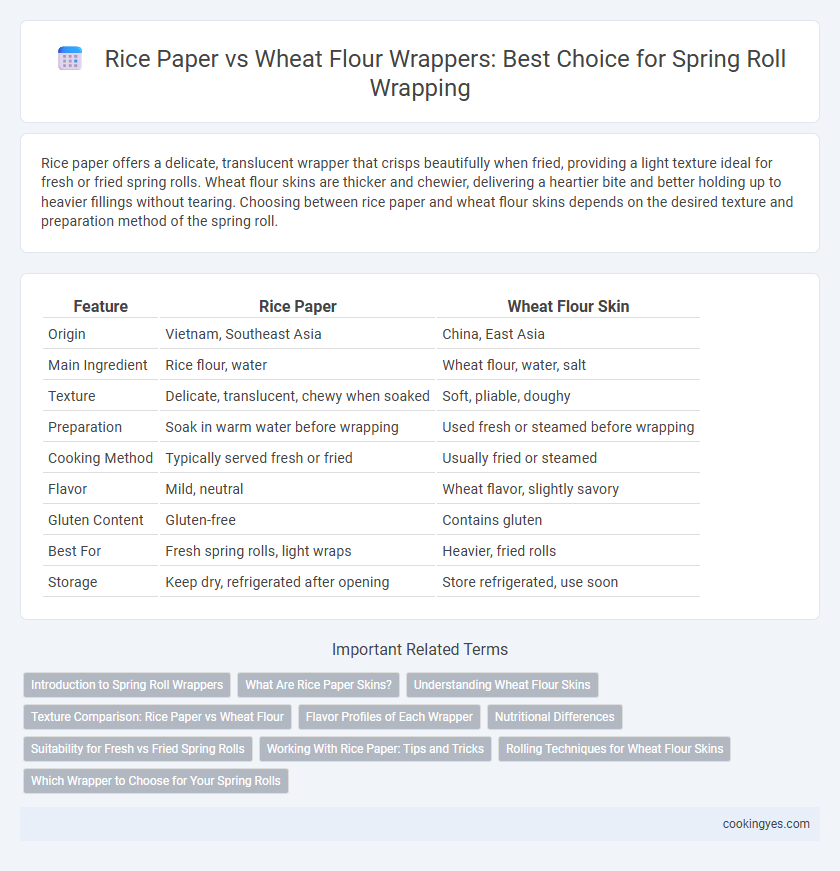Rice paper offers a delicate, translucent wrapper that crisps beautifully when fried, providing a light texture ideal for fresh or fried spring rolls. Wheat flour skins are thicker and chewier, delivering a heartier bite and better holding up to heavier fillings without tearing. Choosing between rice paper and wheat flour skins depends on the desired texture and preparation method of the spring roll.
Table of Comparison
| Feature | Rice Paper | Wheat Flour Skin |
|---|---|---|
| Origin | Vietnam, Southeast Asia | China, East Asia |
| Main Ingredient | Rice flour, water | Wheat flour, water, salt |
| Texture | Delicate, translucent, chewy when soaked | Soft, pliable, doughy |
| Preparation | Soak in warm water before wrapping | Used fresh or steamed before wrapping |
| Cooking Method | Typically served fresh or fried | Usually fried or steamed |
| Flavor | Mild, neutral | Wheat flavor, slightly savory |
| Gluten Content | Gluten-free | Contains gluten |
| Best For | Fresh spring rolls, light wraps | Heavier, fried rolls |
| Storage | Keep dry, refrigerated after opening | Store refrigerated, use soon |
Introduction to Spring Roll Wrappers
Rice paper and wheat flour skins serve as the primary spring roll wrappers, each bringing unique textures and flavors to the dish. Rice paper offers a translucent, delicate, and slightly chewy texture that crisps up beautifully when fried or remains soft for fresh rolls, making it ideal for Vietnamese and Thai spring rolls. Wheat flour skins provide a thicker, more pliable wrap with a subtle wheat flavor, commonly used in Chinese spring rolls, delivering a crispy and hearty bite when fried.
What Are Rice Paper Skins?
Rice paper skins for spring rolls are thin, translucent wrappers made primarily from rice flour, water, and sometimes tapioca starch, offering a delicate texture and a slightly chewy bite. They are naturally gluten-free, making them an ideal choice for gluten-sensitive or gluten-intolerant individuals, unlike wheat flour skins that contain gluten. Rice paper skins soften quickly when dipped in water, providing a smooth, pliable surface perfect for fresh spring rolls filled with vegetables, herbs, and protein.
Understanding Wheat Flour Skins
Wheat flour skins for spring rolls offer a pliable texture and a slightly chewy bite, distinguishing them from the translucent, delicate rice paper skins. Rich in gluten, wheat flour skins provide a sturdy wrapper that maintains its integrity during frying, resulting in a crisp and golden exterior. Their robust flavor profile enhances savory fillings, making them a popular choice in many Asian spring roll recipes.
Texture Comparison: Rice Paper vs Wheat Flour
Rice paper spring roll wrappers offer a delicate, slightly chewy texture that becomes translucent when moistened, providing a light and crisp bite. Wheat flour skins deliver a thicker, more elastic wrap that remains soft and pliable after cooking, lending a heartier mouthfeel. The choice between rice paper and wheat flour skins significantly influences the spring roll's overall texture, with rice paper favored for crispness and wheat flour for a tender, doughier consistency.
Flavor Profiles of Each Wrapper
Rice paper wrappers offer a delicate, slightly sweet flavor that complements fresh herbs and vegetables in spring rolls, enhancing the overall light and refreshing taste. Wheat flour skins provide a richer, more neutral base with a subtle chewiness that pairs well with savory, robust fillings like grilled meats or fried ingredients. Choosing between rice paper and wheat flour skins depends largely on the desired textural contrast and flavor balance in your spring roll recipe.
Nutritional Differences
Rice paper spring roll wrappers are typically lower in calories and carbohydrates compared to wheat flour skins, making them a preferred choice for low-calorie diets. Rice paper is gluten-free and contains less fat, making it suitable for gluten-intolerant individuals and those seeking lighter options. Wheat flour skins offer higher protein and fiber content, contributing to increased satiety and nutritional value, but they also have a higher glycemic index.
Suitability for Fresh vs Fried Spring Rolls
Rice paper is highly suitable for fresh spring rolls due to its delicate, translucent texture that softens when moistened, preserving a light and fresh bite. Wheat flour skins, with a thicker and more robust consistency, excel in fried spring rolls by providing a crispy, golden exterior that withstands high frying temperatures. Choosing rice paper enhances freshness and moisture retention, while wheat flour skins optimize crunch and structural integrity in fried variations.
Working With Rice Paper: Tips and Tricks
Rice paper offers a delicate, translucent wrapper for spring rolls, providing a light and chewy texture that contrasts with the denser wheat flour skins. To work effectively with rice paper, soak each sheet briefly in warm water until just pliable, avoiding over-soaking to prevent tearing. Handling rice paper gently and rolling tightly with moist fillings ensures a neat, intact spring roll that holds its shape during frying or serving fresh.
Rolling Techniques for Wheat Flour Skins
Wheat flour skins for spring roll wrapping require a different rolling technique compared to rice paper, as they are more pliable and less prone to tearing. When rolling, it's essential to keep the filling tight and evenly distributed while folding the edges inward to prevent spillage during frying. Applying a light water or egg wash along the edges helps seal the wrap, ensuring a crisp and well-structured spring roll.
Which Wrapper to Choose for Your Spring Rolls
Rice paper wrappers offer a translucent, delicate texture that crisps up quickly when fried or stays soft when fresh, making them ideal for traditional Vietnamese spring rolls. Wheat flour skins provide a thicker, chewier consistency, holding up well to frying and delivering a heartier bite, often used in Chinese-style spring rolls. Choose rice paper for light, fresh rolls with delicate fillings, or wheat flour skins for a robust, crispy exterior that supports denser ingredients.
Rice paper vs Wheat flour skins for Spring roll wrapping Infographic

 cookingyes.com
cookingyes.com